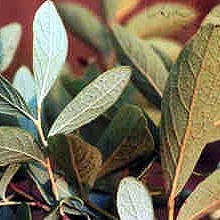Plants 7.5-20 dm, forming small to extensive colonies; branches spreading; twigs of current season pale green, glabrous or glabrate. Leaves: petiole 2-3 mm; blade greenish white, glaucescent abaxially, green to yellowish green, dull green adaxially, ovate to oblong, 2.5-5(-6) × 2-3 cm, subcoriaceous, base cuneate, margins entire, apex rounded to obtuse, surfaces short-hairy (hairs white) or glabrous, sessile-glandular abaxially. Inflorescences drooping, 2-4-flowered, sometimes flowers solitary, bracteate, 1-4.5 cm, glabrous or pilose; bracts early-deciduous, leaflike or not, 5-6 mm, shorter than pedicels, sessile-glandular, sparsely hairy. Pedicels 8-15(-20) mm, glabrous, sessile-glandular; bracteoles 1-2, 1-2.5 mm, (sessile-glandular). Flowers: sepals 5, 1-1.2 mm, glabrous, sessile-glandular; petals 5, corolla greenish white, campanulate-conic, 3-5 mm, lobes deltate, 1-1.4 mm; filaments 0.5-1 mm, pilose; anthers included (tips barely exserted), 2.5 mm, thecae not divergent distally; ovary glabrous. Drupes juicy, sweet, blue (sometimes black, rarely white), glaucescent, 5-8 mm diam., glabrous. Seeds 1.5 mm.
More
Widely branched, to 2 m; lvs deciduous, elliptic or oblong to oblong-obovate, 3–6 cm, beset with minute, sessile, resinous glands beneath; racemes slender, loose, usually surpassing the lvs; bracts linear-oblong to elliptic, deciduous; pedicels usually much longer than the fls; pubescence of the infl and fls sparse or none, the glands sessile, if present, and the sep not ciliate; cor 3–4.5 mm, its tube two-thirds as thick; fr dark blue, glaucous, 7–8 mm. Moist woods and thickets, mostly near the coast; N.H. to Fla. and Ala., and sometimes inland to O., W.Va., and Tenn. May, June. (Decachaena f.)
A small shrub. It grows 1-2 m tall. The stems are long and arching. The flowers are small and pinkish-green. The fruit are large, bluish and rather acid.

